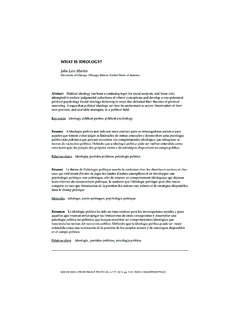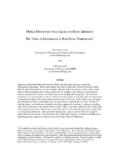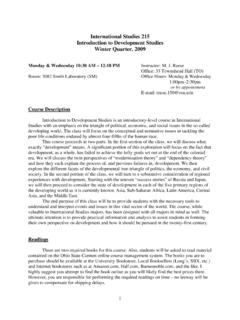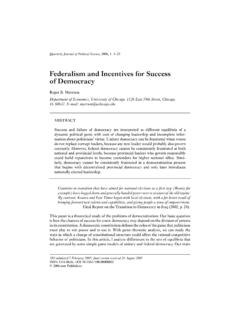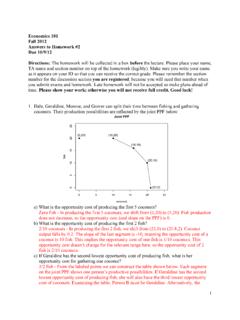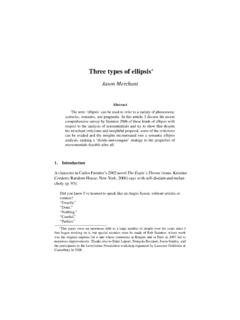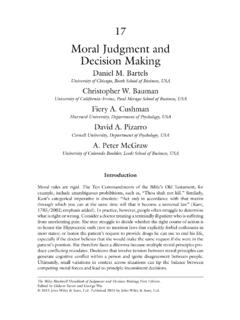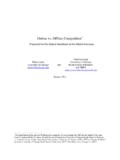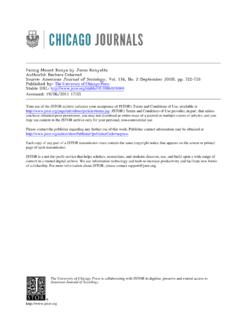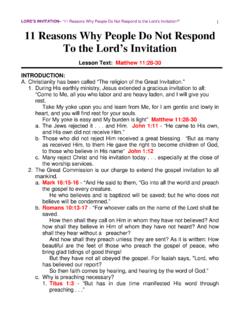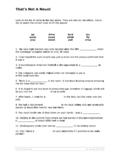Transcription of Haeckel’s embryos: fraud not proven - University of …
1 haeckel s embryos: fraud not provenRobert J. RichardsPublished online: 5 November 2008 Springer Science+Business Media 2008 Through the last half of the nineteenth century and the first part of the twentieth, noscientist more vigorously defended Darwinian theory than the German ErnstHaeckel (1834 1919). More people learned of the new ideas through hisvoluminous publications, translated into numerous languages, than through anyother source, including Darwin s own writings. He enraged many of hiscontemporaries, especially among the religiously orthodox; and the enmity betweenevolutionary theory and religious fundamentalism that still burns brightly today mayin large measure be attributed to haeckel s unremitting attacks on the ingressions ofreligion into science.
2 Though he retained a life-long friendship with and the supportof Darwin, some in the scientific community who were critical of evolutionarytheory Emil Du Bois-Reymond, Rudolf Virchow, and Louis Agassiz, forinstance accused him of deception. That charge has been renewed in our timebased on seemingly incontrovertible aSciencemagazine article published in 1997, haeckel s Embryos: FraudRediscovered, haeckel , was indicted of having intentionally misrepresentedembryological development (Pennisi1997). The article reported that the work ofMichael Richardson and his colleagues demonstrated this malfeasance through acomparison of haeckel s illustrations of early-stage embryos with photographs ofthe same species at a comparable stage (see ).
3 The photos showed embryos ofvarious species that differed among themselves and certainly from haeckel simages. The differences were striking and the implication obvious: fraudulentmisrepresentation. Richardson, as quoted in the article, affirmed the charge: Itlooks like it s turning out to be one of the most famous fakes in biology R. J. Richards (&)Morris Fishbein Center for the History of Science, The University of Chicago, 1126 E. 59th St.,Chicago, IL 60637, USAe-mail: Philos (2009) 24:147 154 DOI (Pennisi1997).1 The popular press immediately picked up the story, running it undersuch headlines as: An Embryonic Liar (Hawkes1997). It was not long thereafterthat creationists and advocates of intelligent design ignited thousands of websites inan electronic auto-da-fe wherein haeckel s reputation and that of Darwinian theorygenerally were sacrificed to appease an angry God (see the use made of the work ofRichardson et al.)
4 By the creationist Jonathan Wells in Wells2000,2006). It had longbeen assumed that haeckel s racist construction of human evolution had contributedto the work of the Nazis, and now the photographic evidence seemed to confirm hismeretricious character. Many reputable biologists quickly accepted the conclusion oftheSciencearticle, but then sought to distance haeckel s version of evolution fromthat of Darwin. Stephen Jay Gould, for example, thought the indictment justifiedLouis Agassiz s judgment of haeckel : Abscheulich!(Atrocious!) (Gould2000).Ever since the appearance of his bookOntogeny and Phylogeny(1977), Gould hadbeen trying to distinguish haeckel s evolutionary views from Darwin s especiallyconcerning the idea that the development of a given embryo morphologicallyrecapitulated the evolutionary history of its phylum.
5 Richardson s evidence gavedramatic support for Gould s many efforts to discredit haeckel (see, , Gould1977,1980,1985,1989,2003). The historical and biological evidence, however,shows the charge against haeckel to be logically mischievous, historically naive, andfounded on highly misleading its report on an article by Richardson et al. (1997)inAnatomy andEmbryology. They argued that vertebrates did not go through an earlyFig. 1 Illustration from Elizabeth Pennisi, haeckel s Embryos: fraud Rediscovered, Science, 19971 Though Richardson never retracted this judgment, he seems to have moderated his view in a subsequentarticle (see Richardson and Keuck2003). The authors write: haeckel s much criticized embryodrawings are important as phylogenetic hypotheses, teaching aids, and evidence for evolution.
6 Whilesome criticisms of the drawings are legitimate, other are more tendentious (p. 495).148R. J. Richards123embryological stage (the so called phylotypic stage ) in which different specieswere morphologically quite similar, although this had been the conviction of manyembryologists of the past and the present. They maintained that not only didHaeckel s images misrepresent the actual state of embryos but so did those ofWilhelm His, perhaps the most famous embryologist of his day and haeckel s bitterenemy. His, they contended, also exaggerated the similarities of embryos andignored their differences. The main point of the article by Richardson and hiscolleagues, however, was to show that embryologists in the late twentieth centurydid little better.
7 The authors, though, accused no one of fraud . That charge wasmade in theSciencearticle, and then only against haeckel . Parity of reasoningshould logically have required another conclusion: if the indictment of fraud shouldbe made against haeckel because of too-similar images, then it ought to be broughtalso against His and the many modern embryologists whom Richardson and hiscolleagues cited, since they, too, supposed a phylotypic stage in embryogenesis(Richardson et al. cite the following modern embryologists as believing in aphylotypic stage in which vertebrate embryos very closely resemble one another:Butler and Juurlink1987; Wolpert1991; Slack et ; Alberts et ;Collins1995). Actually, these recent embryologists ought to have been judged moreculpable, given the increase of knowledge, standards, and instrumentation duringthe last 125 and his colleagues chose to compare their photographs with imagestaken from haeckel sAnthropogenie: oder, Entwickelungsgeschichte des Menschen(Anthropogenie: or the developmental history of man) (Haeckel1874).
8 This wasone of haeckel s popular defenses of evolutionary theory. The book grew out of aseries of lectures that he gave to a general audience in 1873; he then quicklyredacted them from stenographic notes taken by two of his students. haeckel slectures and his volume were replete with many illustrations by his own hand,including the comparative illustration supporting the recapitulation hypothesis( ). It was from this latter that Richardson and his colleagues selected imagesof embryos for are several matters of historical importance that one must keep in mindwhen judging the veracity of haeckel s work. First, his lectures were meant for apopular audience, and thus some didactic license would have been , haeckel was a marine biologist, not a vertebrate biologist, though highlyskilled in the latter field.
9 Consequently he borrowed and adapted many of hisillustrations, with acknowledgment, from experts in vertebrate biology. From ourperspective, these images are a bit crude. If one compares haeckel s images ofembryos at the intermediate stage with those used by Darwin in theDescent of Man( ), one can appreciate the schematic character of images typical of the , Darwin acknowledged that he borrowed his images from two of the samesources as did haeckel (Darwin1871, p. 16). Since Darwin also attempted to drivehome the similarities of vertebrate embryos, perhaps not even he should escapecondemnation. Third, in theSciencearticle, Richardson suggested that haeckel fudged the scale of the embryos, even though there was a tenfold difference inmagnitude among them.
10 haeckel , however, quite explicitly stated in the caption tohis illustration that he reduced all of the images to the same size to facilitateHaeckel s embryos: fraud not proven149123structural comparisons (Haeckel1874, p. 256). Finally, Richardson and hiscolleagues selected images from the first edition of haeckel sAnthropogenie, whichwas hastily drawn together from his lectures. The book, though, went through fivefurther editions. With each new edition the text grew fatter as haeckel deployedmore evidence; and the illustration in question expanded the comparison from 8species of embryo to 20 by the 5th edition (1905). In the subsequent editions, theimages grew ever more refined, so that even by the 4th edition (1891), thedifferences among them became more pronounced ( ).
